Identifying Key Factors in Determining Disparities in Energy Consumption in China: A Household Level Analysis
Abstract
:1. Introduction
2. Literature Review
2.1. Disparities in Energy Consumption and Determinants
2.2. Hypotheses Development
3. Data
3.1. Data Source
3.2. Data Collection
4. Methodology
4.1. Gini Coefficient and Lorentz Curve
4.2. Lorentz Asymmetry Coefficient
4.3. Decomposing Gini Coefficient by Energy-Consumption Composition
4.4. Decomposing Gini Coefficient by Urban–Rural Areas and Regions
5. Differences in Energy Consumption by Energy Types
5.1. Descriptive Statistics
5.2. Analysis Based on Gini Coefficient and Lorentz Asymmetry Coefficient
6. Differences in Energy Consumption by End Uses
6.1. Descriptive Statistics
6.2. Analysis Based on Gini Coefficient and Lorentz Asymmetry Coefficient
6.3. Analysis Based on Decomposing Gini Coefficient
7. Energy-Consumption Differences in Urban–Rural Areas
7.1. Analysis Based on Gini Coefficient and Lorenz Curve
7.2. Analysis Based on Decomposing Gini Coefficient
8. Energy-Consumption Differences among Regions
8.1. Analysis Based on Gini Coefficient and Lorenz Curve
8.2. Analysis Based on Decomposing Gini Coefficient
9. Conclusion and Policy Implications
9.1. Conclusions
9.2. Policy Implications
Author Contributions
Funding
Institutional Review Board Statement
Informed Consent Statement
Data Availability Statement
Acknowledgments
Conflicts of Interest
References
- Hasan, S.A.; Mozumder, P. Income and energy use in Bangladesh: A household level analysis. Energy Econ. 2017, 65, 115–126. [Google Scholar] [CrossRef] [Green Version]
- Cao, J.; Ho, M.S.; Liang, H. Household Energy Demand in Urban China: Accounting for Regional Prices and Rapid Income Change. Energy J. 2016, 37, 87–110. [Google Scholar] [CrossRef]
- Liu, L.; Yin, C. Gray relational analysis of energy consumption and energy structure in rural areas of China during 1999–2010. Acta Agric. Zhejiangensis 2014, 26, 503–509. [Google Scholar]
- Wang, X.; Zhu, L.; Qian, Y.; Tang, L. Rural Household Energy Consumption in Jiangsu Province Of China. Energy Environ. 2015, 26, 631–642. [Google Scholar]
- Jie, S.; Feng, W. The Impact Assessment of Bio-energy Construction Project on Sustainable Development of Eco-economic of China. In Proceedings of the 2nd International Conference on Risk Management and Engineering Management, Beijing, China, 4–6 November 2008. [Google Scholar]
- Huang, C.; Zhang, Z.; Li, N.; Liu, Y.; Chen, X.; Liu, F. Estimating economic impacts from future energy demand changes due to climate change and economic development in China. J. Clean. Prod. 2021, 311, 127576. [Google Scholar] [CrossRef]
- Jiang, P.; Yang, H.F.; Li, H.M.; Wang, Y. A Developed Hybrid Forecasting System for Energy Consumption Structure Forecasting based on Fuzzy Time Series and Information Granularity. Energy 2021, 219, 119599. [Google Scholar] [CrossRef]
- Liu, Z.Q.; Tang, Y.F.; Zhou, H.R.; Yang, S. Life Cycle Performance of a Distributed Energy System in Comparison with a Conventional Energy System for District Heating and Cooling in China. J. Clean. Prod. 2020, 288, 125663. [Google Scholar] [CrossRef]
- Yang, G.M.; Zhang, F.; Zhang, F.T.; Ma, D.L.; Gao, L.; Chen, Y.; Luo, Y.; Yang, Q. Spatiotemporal Changes in Efficiency and Influencing Factors of China’s Industrial Carbon Emissions. Environ. Sci. Pollut. Res. 2021, 28, 1–15. [Google Scholar] [CrossRef]
- Du, Y.M.; Ma, T. Impact of Electricity Pricing Strategy on Residential Energy Consumption Decisions in China: Empirical Evidence from a Household Survey. J. Environ. Econ. Policy 2021, 1–18. [Google Scholar] [CrossRef]
- Zou, B.L.; Luo, B.L. Rural Household Energy Consumption Characteristics and Determinants in China. Energy 2019, 182, 814–823. [Google Scholar] [CrossRef]
- Jiang, L.; Xue, B.; Liu, H. Quantifying Energy Consumption In Household Surveys And Empirical Research. Renesable Energy Resour. 2021, 39, 885–892. [Google Scholar]
- Ding, N.; Pan, J.; Liu, J.; Yang, J. An Optimization Method for Energy Structures based on Life Cycle Assessment and Its Application to the Power Grid in China. J. Environ. Manag. 2019, 238, 18–24. [Google Scholar] [CrossRef] [PubMed]
- Mardani, A.; Zavadskas, E.K.; Streimikiene, D.; Jusoh, A.; Khoshnoudi, M. A Comprehensive Review of Data Envelopment Analysis (DEA) Approach in Energy Efficiency. Renew. Sustain. Energy Rev. 2017, 70, 1298–1322. [Google Scholar] [CrossRef]
- Evans, A.; Strezov, V.; Evans, T.J. Assessment of Sustainability Indicators for Renewable Energy Technologies. Renew. Sustain. Energy Rev. 2009, 13, 1082–1088. [Google Scholar] [CrossRef]
- Arbolino, R.; Boffardi, R.; De Simone, L.; Ioppolo, G. Who Achieves the Efficiency? A New Approach to Measure Local Energy Efficiency. Ecol. Indic. 2020, 110, 105875. [Google Scholar] [CrossRef]
- Huang, G.; Ouyang, X.; Yao, X. Dynamics of China’s Regional Carbon Emissions under Gradient Economic Development Mode. Ecol. Indic. 2015, 51, 197–204. [Google Scholar] [CrossRef]
- Okushima, S. Understanding Regional Energy Poverty in Japan: A Direct Measurement Approach. Energy Build. 2019, 193, 174–184. [Google Scholar] [CrossRef]
- Li, Q.C.; Hu, J.; Yu, B.L. Spatiotemporal Patterns and Influencing Mechanism of Urban Residential Energy Consumption in China. Energies 2021, 14, 3864. [Google Scholar] [CrossRef]
- Li, Z.; Pan, L.Y.; Fu, F.; Liu, P.; Ma, L.W.; Arnorelli, A. China’s Regional Disparities in Energy Consumption: An Input-Output Analysis. Energy 2014, 78, 426–438. [Google Scholar] [CrossRef]
- Liu, H.; Wang, C.; Tian, M.Y.; Wen, F.H. Analysis of Regional Difference Decomposition of Changes in Energy Consumption in China during 1995–2015. Energy 2019, 171, 1139–1149. [Google Scholar] [CrossRef]
- Chen, J.D.; Cheng, S.L.; Song, M.L. Decomposing Inequality in Energy-Related CO 2 Emissions by Source and Source Increment: The Roles of Production and Residential Consumption. Energy Policy 2017, 107, 698–710. [Google Scholar] [CrossRef]
- Yue, W.; Cai, Y.; Yang, Z.; Rong, Q.; Dang, Z. Structural Optimization for Industrial Sectors to Achieve the Targets of Energy Intensity Mitigation in the Urban Cluster of the Pearl River Delta. Ecol. Indic. 2018, 95, 673–686. [Google Scholar] [CrossRef]
- Zhang, M.S.; Ge, X.; Zhao, Y.; Xia-Bauer, C. Creating Statistics for China’s Building Energy Consumption Using an Adapted Energy Balance Sheet. Energies 2019, 12, 4293. [Google Scholar] [CrossRef] [Green Version]
- Shi, X. Inequality of opportunity in energy consumption in China. Energy Policy 2019, 124, 371–382. [Google Scholar] [CrossRef]
- Dong, F.; Yu, B.; Hua, Y.; Zhang, S.; Wang, Y. A Comparative Analysis of Residential Energy Consumption in Urban and Rural China: Determinants and Regional Disparities. Int. J. Environ. Res. Public Health 2018, 15, 2507. [Google Scholar] [CrossRef] [PubMed] [Green Version]
- Zhou, Q.; Shi, W. Socio-economic Transition and Inequality of Energy Consumption among Urban and Rural Residents in China. Energy Build. 2019, 190, 15–24. [Google Scholar] [CrossRef]
- Fan, J.L.; Chen, K.Y.; Zhang, X. Inequality of Household Energy and Water Consumption in China: An Input-Output Analysis. J. Environ. Manag. 2020, 269, 110716. [Google Scholar] [CrossRef] [PubMed]
- Wu, S.M.; Zheng, X.Y.; Wei, C. Measurement of Inequality Using Household Energy Consumption Data in Rural China. Nat. Energy 2017, 2, 795–803. [Google Scholar] [CrossRef]
- Le, T.-H.; Boubaker, S.; Nguyen, C.P. The Energy-Growth Nexus Revisited: An Analysis of Different Types of Energy. J. Environ. Manag. 2021, 297, 113351. [Google Scholar] [CrossRef]
- Yang, Y.; Liu, J.; Lin, Y.; Li, Q. The impact of urbanization on China’s residential energy consumption. Struct. Chang. Econ. Dyn. 2019, 49, 170–182. [Google Scholar] [CrossRef]
- Wang, S.; Liu, H.; Pu, H.; Yang, H. Spatial disparity and hierarchical cluster analysis of final energy consumption in China. Energy 2020, 197, 117195. [Google Scholar] [CrossRef]
- Wang, X.; Li, N.; Chen, J.; Lu, X. Spatialtemporal Differentiation Characteristics and Driving Forces Of Urban Natural Gas Consumption In China. Fresenius Environ. Bull. 2021, 30, 10205–10214. [Google Scholar]
- Mohammadi, N.; Taylor, J.E. Significance of Scale in Spatial Dependencies of Urban Human Mobility and Energy Use: A Decision Making Perspective. In Proceedings of the International Conference on Sustainable Infrastructure, New York, NY, USA, 26–28 October 2017. [Google Scholar]
- Bian, Y.J.; Li, L.L. The Chinese General Social Survey (2003-8) Sample Designs and Data Evaluation. Chin. Sociol. Rev. 2012, 45, 70–97. [Google Scholar] [CrossRef]
- Jia, G.P. Reasonable Choice of Standard Coefficient of Energy Conversion. Metall. Energy 2011, 1, 3–4+11. [Google Scholar]
- Tan, D.; Huang, X.J. Correlation Analysis and Comparison of Economic Development and Carbon Emissions in the Eastern, Middle and Western Regions of China. Chin. Popul. Resour. Environ. 2008, 3, 54–57. [Google Scholar]
- Li, M.; Li, L. The Impact of Urbanization and Industrialization on Energy Security: A Case Study of China. Energies 2019, 12, 2194. [Google Scholar] [CrossRef] [Green Version]
- Silber, J. Factor Components, Population Subgroups and The Computation of the Gini Index of Inequality. Rev. Econ. Stat. 1989, 71, 107–115. [Google Scholar] [CrossRef]
- Sarabia, J.M.; Castillo, E.; Slottje, D.J. An Ordered Family of Lorenz Curves. J. Econom. 1999, 91, 43–60. [Google Scholar] [CrossRef]
- Fei, J.; Ranis, G.; Kuo, W.Y. Growth and the Family Distribution of Income by Factor Components. Q. J. Econ. 1978, 92, 17–53. [Google Scholar] [CrossRef]
- Asongu, S.A.; Odhiambo, N.M. The green economy and inequality in Sub-Saharan Africa: Avoidable thresholds and thresholds for complementary policies. Energy Explor. Exploit. 2021, 39, 838–852. [Google Scholar] [CrossRef]
- Lawrence, S.; Liu, Q.; Yakovenko, V.M. Global Inequality in Energy Consumption from 1980 to 2010. Entropy 2013, 15, 5565–5579. [Google Scholar] [CrossRef] [Green Version]
- Pascual Saez, M.; Cantarero-Prieto, D.; Pires Manso, J.R. Gross Inland Energy Consumption Inequality in Europe: An Empirical Approach. Rev. De Econ. Mund. 2018, 49, 149–163. [Google Scholar]
- Lee, J. Analysis of the Regional Inequalities of Renewable Energy Resources using Gini’s Coefficients. J. Korean Soc. Rural Plan. 2016, 22, 109–119. [Google Scholar] [CrossRef]
- Roice, T.; Lopez, N.S. Energy Equity Analysis In Metro Manila Using Household Expenditure Data. In Proceedings of the 11th AUN/SEED-Net Regional Conference on Mechanical and Manufacturing Engineering (RCMEManuE 2020), Manila, Philippines, 11–15 January 2021; IOP Publishing: Bristol, UK; 1109, p. 012043. [Google Scholar]
- Damgaard, C.; Weiner, J. Describing inequality in plant size or fecundity. Ecology 2000, 81, 1139–1142. [Google Scholar] [CrossRef]
- Kakwani, N.C. Applications of lorenz curves in economic-analysis. Econometrica 1977, 45, 719–727. [Google Scholar] [CrossRef]
- Seidl, C. Ethical Social Index Numbers—Chakravarty, Sr. J. Econ. Z. Fur Natl. 1992, 55, 222–227. [Google Scholar]
- Li, H. A Research on Gini Coefficient Decomposition Analysis. Quant. Tech. Econ. 2005, 22, 127–135. [Google Scholar]
- Yang, D.T. Urban-Biased Policies and Rising Income Inequality in China. Am. Econ. Rev. 1999, 89, 306–310. [Google Scholar] [CrossRef]
- Kim, M.J.; Kim, Y.R. Characteristics and Determinants of Household Electricity Consumption for Different Levels of Electricity Use in Korea. Trans. Korean Inst. Electr. Eng. 2017, 66, 1025–1031. [Google Scholar]
- Kozarcanin, S.; Andresen, G.; Staffell, I. Estimating Country-Specific Space Heating Threshold Temperatures from National Consumption Data. Energy Build. 2019, 199, 368–380. [Google Scholar] [CrossRef]
- Yang, D.W. Study of Economic Development Trend Based on Electric Power Data Analysis. East China Electric Power 2013, 41, 1292–1295. [Google Scholar]
- Liu, Y.S.; Zhang, Z.W.; Wang, J.Y. Regional Differentiation and Comprehensive Regionalization Scheme of Modern Agriculture in China. Acta Geogr. Sin. 2018, 73, 203–218. [Google Scholar]
- Wang, X.H.; Feng, Z.M. Partition of Regional Types on Rural Household Energy Consumption of Province-Level Regions in China. Int. J. Glob. Energy Issues 2002, 18, 266–273. [Google Scholar]
- Bai, A.Z. Study on the Sustainability of Urban Household Energy Consumption in China. In Proceedings of the 2010 International Symposium on Low-Carbon Economy and Technology Science, Zibo, China, 29–31 October 2010; pp. 334–342. [Google Scholar]
- Sun, C.W.; Ouyang, X.L.; Cai, H.B.; Luo, Z.C.; Li, A.J. Household Pathway Selection of Energy Consumption during Urbanization Process in China. Energy Convers. Manag. 2014, 84, 295–304. [Google Scholar] [CrossRef]
- Wang, X.H.; Li, K.Q.; Li, H.; Bai, D.; Liu, J.R. Research on China’s Rural Household Energy Consumption—Household Investigation of Typical Counties in 8 Economic Zones. Renew. Sustain. Energy Rev. 2017, 68, 28–32. [Google Scholar]
- Meng, M.; Wang, L.X.; Shang, W. Decomposition and Forecasting Analysis of China’s Household Electricity Consumption Using Three-Dimensional Decomposition and Hybrid Trend Extrapolation Models. Energy 2018, 165, 143–152. [Google Scholar] [CrossRef]
- Zhang, H.Y.; Lahr, M. Households’ Energy Consumption Change in China: A Multi-Regional Perspective. Sustainability 2018, 10, 2486. [Google Scholar] [CrossRef] [Green Version]
- Lin, T.Y.; Chiu, S.H. Sustainable Performance of Low-Carbon Energy Infrastructure Investment on Regional Development: Evidence from China. Sustainability 2018, 10, 4657. [Google Scholar] [CrossRef] [Green Version]
- Zhou, Y.; Zhang, S.X.; Lin, Y.; Gao, Y. A Game Study on Developing Low Carbon Economy by Using Biomass Energy in Chinese Rural Areas. In Proceedings of the 7th Euro-Asia Conference on Environment and CSR, Huangshan, China, 9–12 May 2011. [Google Scholar]
- Xu, X.H.; Li, Z. Research on Chinese Electrovalent Subsidy Policy for Biomass Energy Electricity Generation Industry. In Proceedings of the International Conference on Management Science and Engineering, Melbourne, VIC, Australia, 24–26 November 2010; pp. 1594–1599. [Google Scholar]
- Saboohi, Y. An Evaluation of the Impact of Reducing Energy Subsidies on Living Expenses of Households. Energy Policy 2001, 29, 245–252. [Google Scholar] [CrossRef]
- Wang, Q.W.; Zhou, B.; Zhang, C.; Zhou, D.Q. Do Energy Subsidies Reduce Fiscal and Household Non-Energy Expenditures? A regional heterogeneity assessment on coal-to-gas program in China. Energy Policy 2021, 155, 112341. [Google Scholar] [CrossRef]

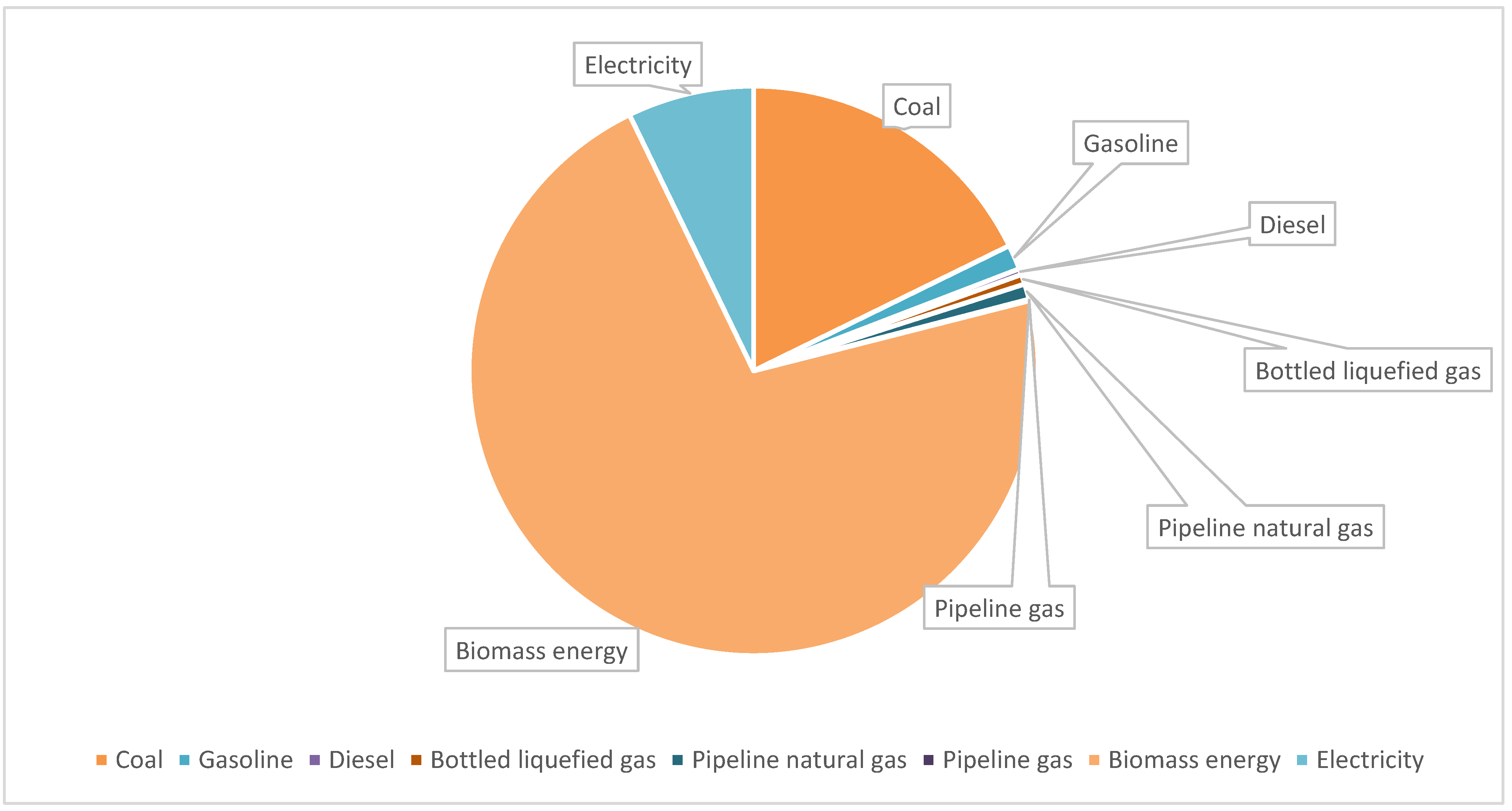
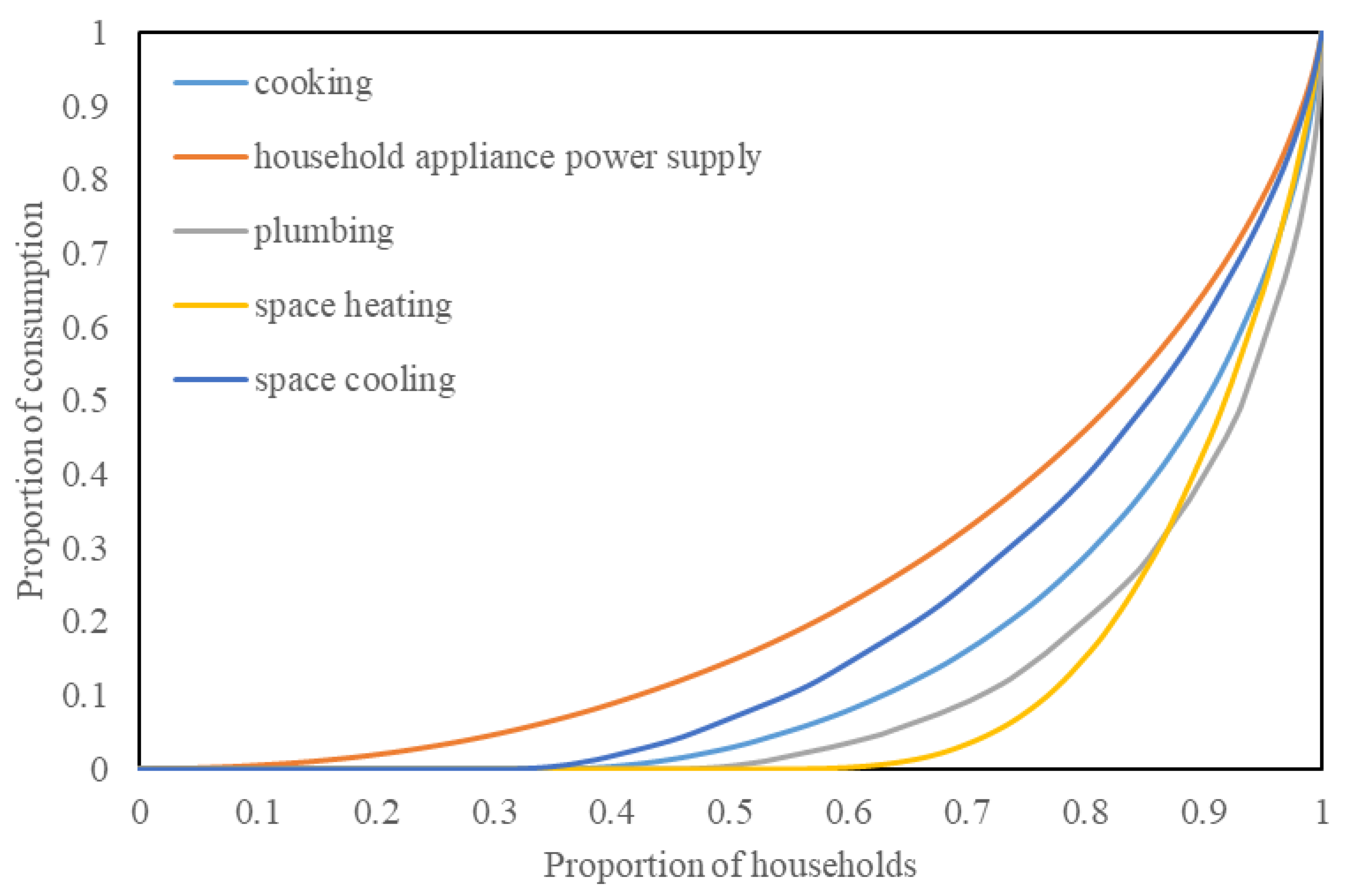
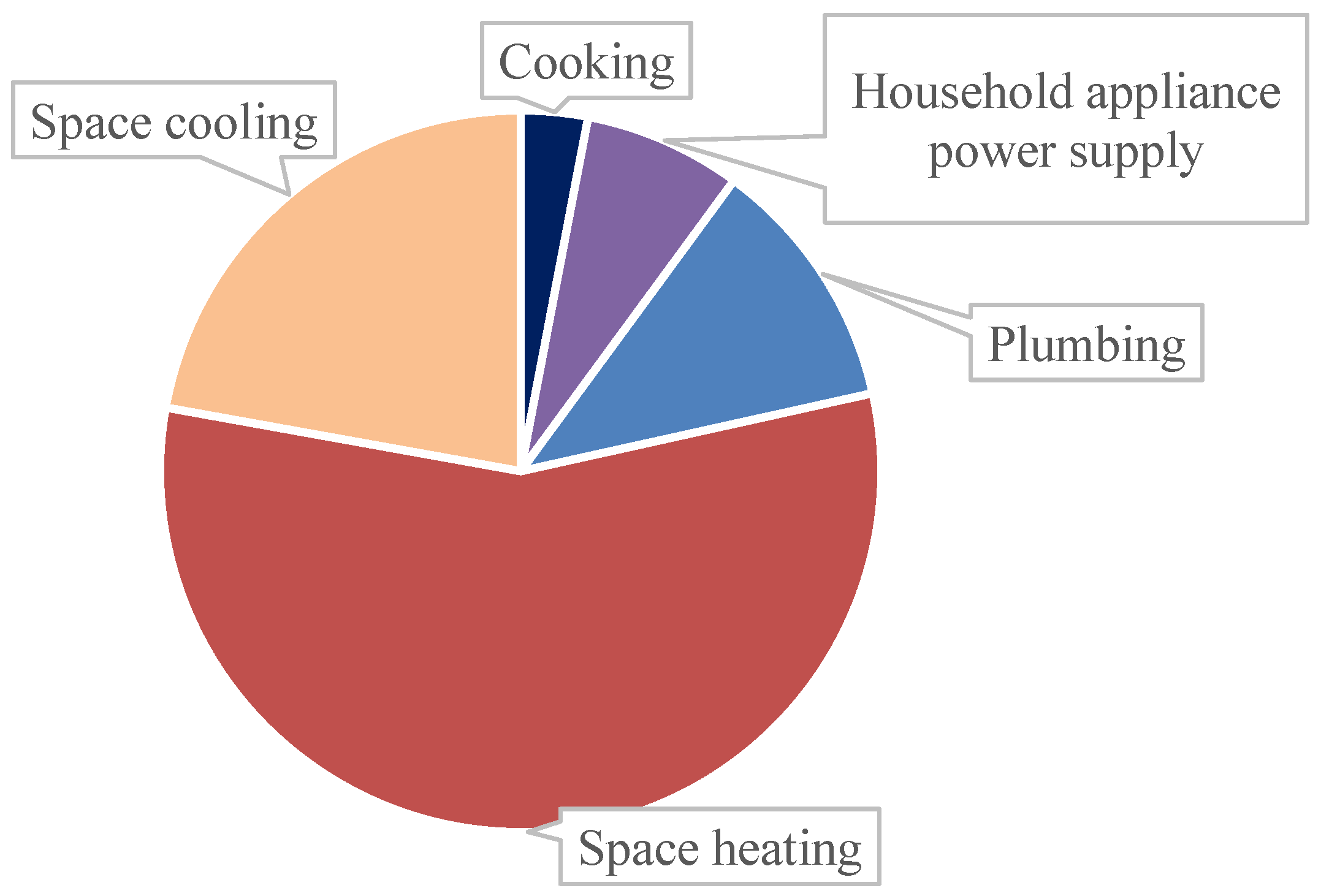
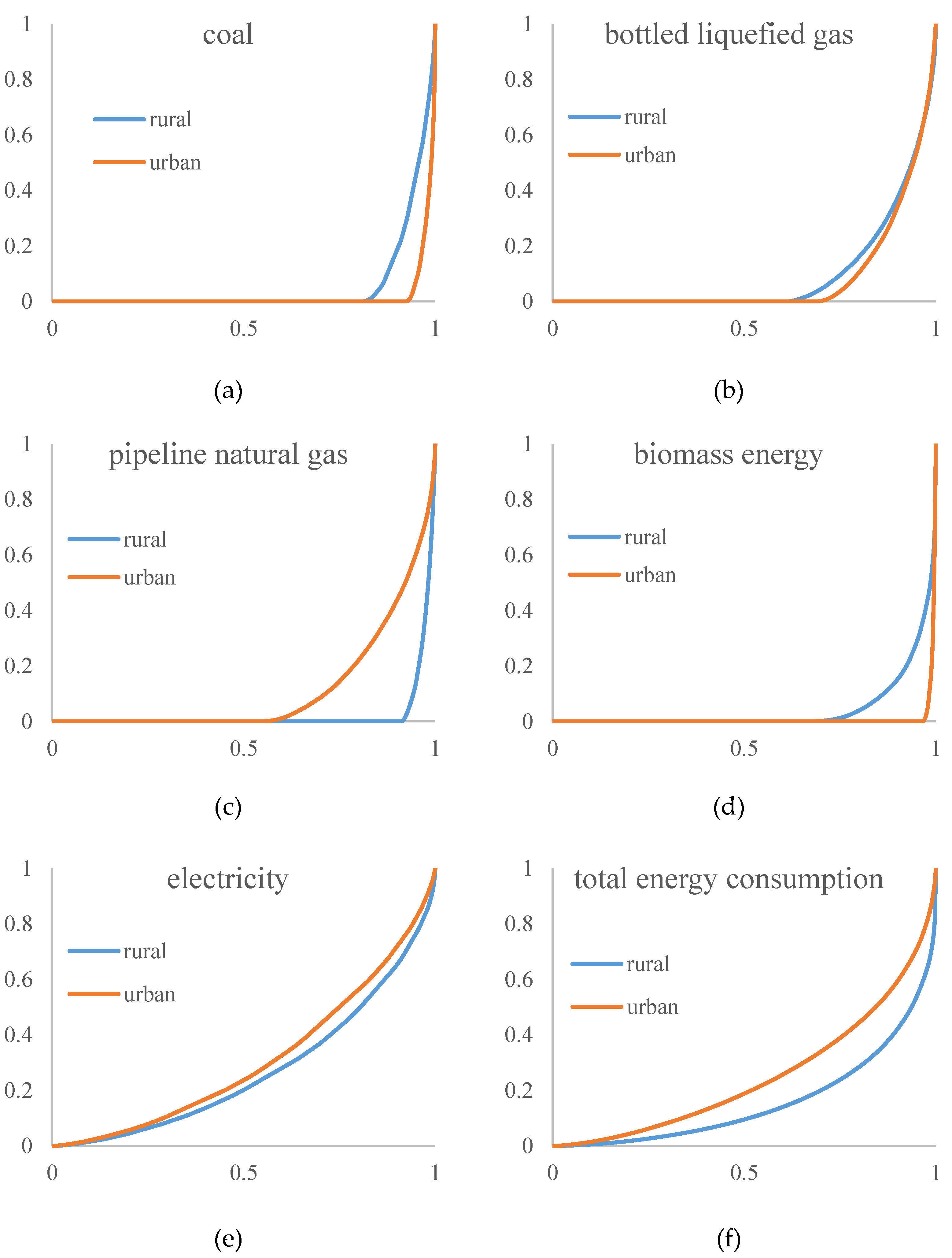
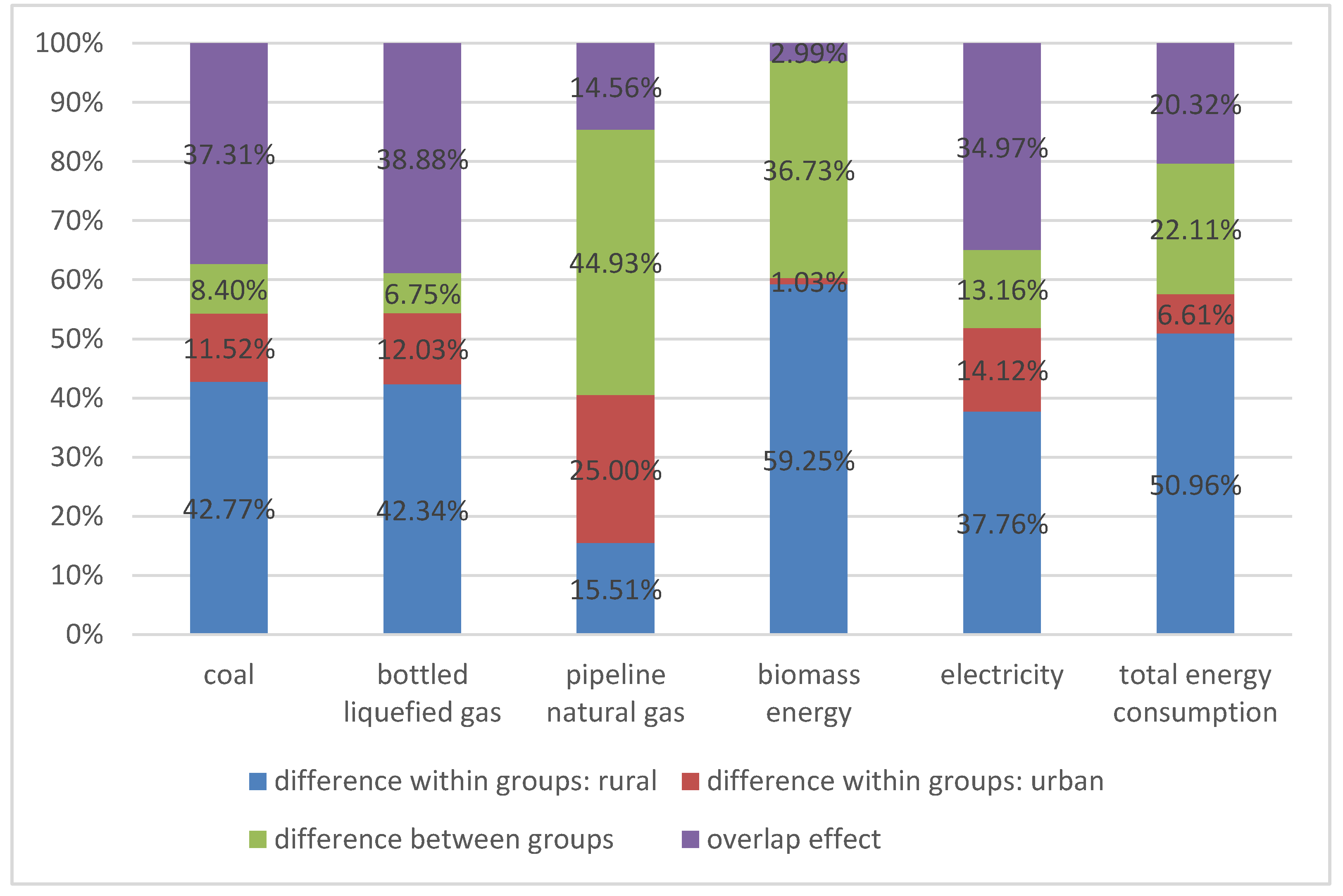
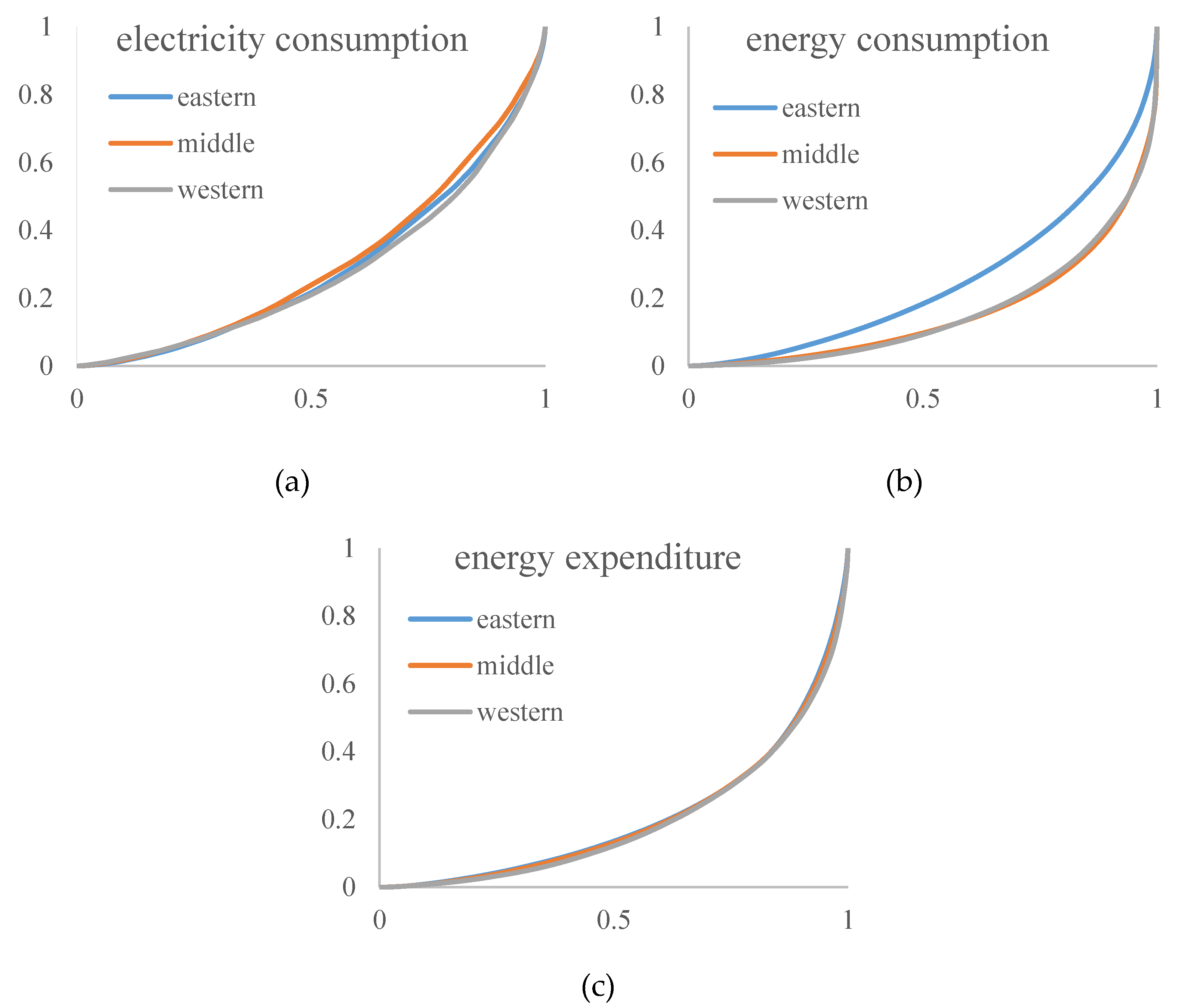
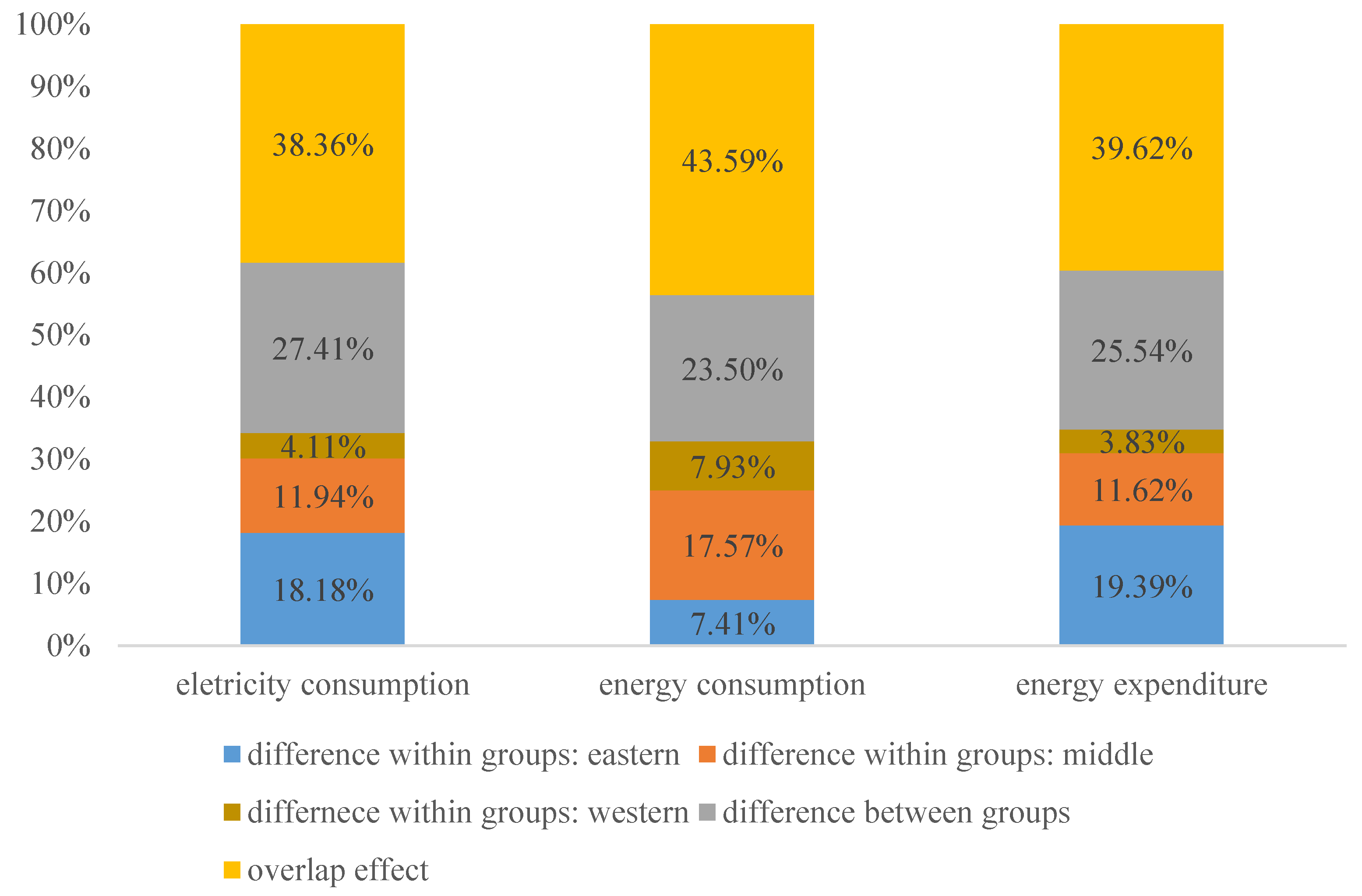
| Coal | Gasoline | Diesel | Bottled Liquefied Petroleum-Gas | Pipeline Natural Gas | Pipeline Gas | Biomass Energy | Electricity | Total Energy Consumption | |
|---|---|---|---|---|---|---|---|---|---|
| Number of households | 384 | 75 | 21 | 894 | 555 | 74 | 565 | 2477 | 2480 |
| Proportion of households | 15.47% | 3.02% | 0.85% | 36.00% | 22.35% | 2.98% | 22.75% | 99.76% | 1 |
| Sum of consumption (kgce) | 428,931.8 | 63,051.8 | 23,219.3 | 227,317.4 | 213,419.7 | 12,804.2 | 1,407,076.0 | 508,181.3 | 2,884,001.5 |
| Proportion of consumption | 14.87% | 2.19% | 0.81% | 7.88% | 7.40% | 0.44% | 48.79% | 17.62% | 1 |
| Average of user consumption (kgce) | 1117.01 | 840.69 | 1105.68 | 254.27 | 384.54 | 173.03 | 2490.4 | 205.16 | 1162.9 |
| Coal | Gasoline | Diesel | Bottled Liquefied Petroleum-Gas | Pipeline Natural Gas | Pipeline Gas | Biomass Energy | Electricity | Total Energy Consumption | |
|---|---|---|---|---|---|---|---|---|---|
| Gini coefficient | 0.9216 | 0.9850 | 0.9974 | 0.8201 | 0.8848 | 0.9865 | 0.9423 | 0.4325 | 0.6449 |
| Lorentz asymmetry coefficient | 0.8421 | 0.7706 | 0.9417 | 0.9427 | 1.0445 | 1.0385 | 1.0065 | 0.9857 | 1.0707 |
| Cooking | Household Appliance Power Supply | Plumbing | Space Heating | Space Cooling | Total Energy Consumption | |
|---|---|---|---|---|---|---|
| Number of households | 2367 | 3628 | 1957 | 1624 | 2491 | 3634 |
| Proportion of households | 65.13% | 99.83% | 53.85% | 44.69% | 68.55% | 1 |
| Sum of consumption (kgce) | 148,458.2 | 327,898.6 | 350,694.4 | 1,208,175 | 661,111.4 | 2,696,337 |
| Proportion of consumption | 5.51% | 12.16% | 13.01% | 44.81% | 24.52% | 1 |
| Average of user consumption (kgce) | 62.72 | 90.38 | 179.2 | 743.95 | 265.4 | 741.98 |
| Cooking | Household Appliance Power Supply | Plumbing | Space Heating | Space Cooling | Total Energy Consumption | |
|---|---|---|---|---|---|---|
| Gini coefficient | 0.7058 | 0.5181 | 0.7791 | 0.7927 | 0.6149 | 0.5175 |
| Lorentz asymmetry coefficient | 0.9645 | 0.9176 | 0.9833 | 0.7752 | 0.9922 | 0.8979 |
| Coal | Bottled Liquefied Gas | Pipeline Natural Gas | Biomass Energy | Electricity | Total Energy Consumption | |||||||||||||
|---|---|---|---|---|---|---|---|---|---|---|---|---|---|---|---|---|---|---|
| Urban | Rural | Total | Urban | Rural | Total | Urban | Rural | Total | Urban | Rural | Total | Urban | Rural | Total | Urban | Rural | Total | |
| Gini coefficient | 0.965 | 0.891 | 0.921 | 0.835 | 0.810 | 0.820 | 0.771 | 0.951 | 0.884 | 0.986 | 0.913 | 0.942 | 0.381 | 0.455 | 0.432 | 0.497 | 0.680 | 0.645 |
| Lorentz asymmetry coefficient | 0.934 | 0.846 | 0.787 | 0.774 | 0.798 | 0.914 | 0.971 | 0.922 | 0.945 | 1.049 | 1.099 | 1.075 | ||||||
| Electricity Consumption | Energy Consumption | Energy Expenditure | ||||
|---|---|---|---|---|---|---|
| Gini Coefficient | Lorentz Asymmetry Coefficient | Gini Coefficient | Lorentz Asymmetry Coefficient | Gini Coefficient | Lorentz Asymmetry Coefficient | |
| Eastern | 0.4246 | 0.9619 | 0.5044 | 1.0856 | 0.5874 | 1.1044 |
| Middle | 0.3919 | 1.0044 | 0.6833 | 1.0647 | 0.5949 | 1.0894 |
| Western | 0.4397 | 0.9444 | 0.6828 | 1.0829 | 0.6080 | 1.0587 |
| Total | 0.4321 | 0.6452 | 0.6090 | |||
Publisher’s Note: MDPI stays neutral with regard to jurisdictional claims in published maps and institutional affiliations. |
© 2021 by the authors. Licensee MDPI, Basel, Switzerland. This article is an open access article distributed under the terms and conditions of the Creative Commons Attribution (CC BY) license (https://creativecommons.org/licenses/by/4.0/).
Share and Cite
Yang, L.; Zhao, K.; Zhao, Y.; Zhong, M. Identifying Key Factors in Determining Disparities in Energy Consumption in China: A Household Level Analysis. Energies 2021, 14, 7149. https://doi.org/10.3390/en14217149
Yang L, Zhao K, Zhao Y, Zhong M. Identifying Key Factors in Determining Disparities in Energy Consumption in China: A Household Level Analysis. Energies. 2021; 14(21):7149. https://doi.org/10.3390/en14217149
Chicago/Turabian StyleYang, Ling, Kai Zhao, Yankai Zhao, and Mengyuan Zhong. 2021. "Identifying Key Factors in Determining Disparities in Energy Consumption in China: A Household Level Analysis" Energies 14, no. 21: 7149. https://doi.org/10.3390/en14217149
APA StyleYang, L., Zhao, K., Zhao, Y., & Zhong, M. (2021). Identifying Key Factors in Determining Disparities in Energy Consumption in China: A Household Level Analysis. Energies, 14(21), 7149. https://doi.org/10.3390/en14217149






